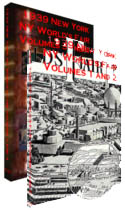The 1939 New York World’s Fair was a remarkable place that drew huge crowds during its existence. It resonated with the people of New York and of the world at a time when the world was still weary from World War I and the great depression and didn’t want to hear about the rumblings of World War II.
 In spite of the planners best efforts for an enlightened event, they couldn’t fight the need of the masses for fun entertainment. As a result, the amusement area was the biggest hit of the fair – which surprised the planners as it was just thrown in there because fairs needed amusement areas. It was not a highly organized affair like the exhibit zones were.
In spite of the planners best efforts for an enlightened event, they couldn’t fight the need of the masses for fun entertainment. As a result, the amusement area was the biggest hit of the fair – which surprised the planners as it was just thrown in there because fairs needed amusement areas. It was not a highly organized affair like the exhibit zones were.
One of the great pasttimes of fair goers was the dancing that went on in the amusement zone. It was so popular that even as the NY World Fair was winding down, they were still promoting the dancing at the fair in the streets of New York including Wall Street and they brought out the big guns like Mister Bo Jangles tohelp in the promotion.
This video clip captures the fun of the dancing at the fair and in the streets of New York during that time.
[youtube width=”350″ height=”288″]s4xggfNWxdc[/youtube]
This 1.5 minute video clip is from a World War II film for U.S Soldiers explaining how the Nazis are destroying God and all people who worship a god. It is a very powerful piece showing a regime usnig every effort available to eradicate god from its society.
[youtube width=”350″ height=”288″]tfMPNd_sxEk[/youtube]
One of the basic tenets of the civil war was to prevent the state secession. This video clip -just over one minute in length gives a nice, easy to understand explanation of this cornerstone of the civil war.
[youtube width=”350″ height=”288″]RhD_w5htE10[/youtube]
After WWII, the Auschwitz death camp was turned into a museum to remember the horror that occurred there. Now 51 years later, there are plans to renovate the holocaust museum to ensure that it is preserved so future generations can still experience first hand the conditions and tortures of these concentration camps.
Plans include reinforcing the ground under two of the gas chambers with underground walls so they can stop sinking into the ground. Underground walls will be used to ensure that nothing is altered on these two death camp gas chambers. No changes would be made to the other parts of the holocaust camp – including the watch towers, crematoria and barracks – as they are still in good condition and not in danger of ground sinking like the two gas chambers.
Also slated is a revamping of the museum to make it more modern. While it will still hold its traditional Shoah (holocaust) exhibits – including hair, glasses and other personal belongings taken from the victims – it will expand to offer multimedia presentations to help explain the story of what happened there so many years ago.
Here is a great resource for those interested in nuclear weapons tests.
It is called
United States Nuclear Tests, July 1945 through September 1992
It is a chronological and alphabetical by name all nuclear tests and simultaneous detonations conducted by the United States. Detonation time and locations (latitude, longitude, and surface elevation) are included in the manual. Basically it is a one stop guide to the history of nuclear tests conducted by the United States before the nuclear weapon test ban.
It is in pdf format and is 185 pages long and fully indexed to make finding the particular nuclear weapons tests that you want quite easy. One if its most interesting features is the variety of maps showing where nuclear tests were conducted in both a large scale format and a grid format so you can get a really good feel for where each test was conducted in the larger testing area.
